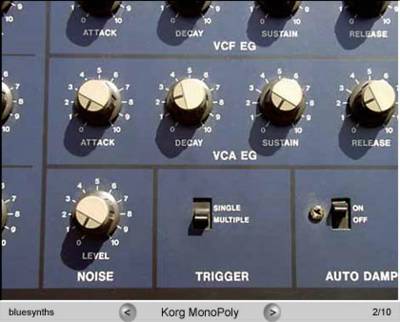I've used quite a few of the damn things over the years. During more affluent times, I had anything up to eight or nine of 'em at a time! These days I have very little equipment at all. Looking at these superbly reproduced close-up images is almost like seeing an intimate photo of an old girlfriend. The 'hands-on' nature of analogues, coupled with their unique features and quirks, does tend to make one build up a sort of 'relationship' with them. They can be stubborn, unpredictable lovers, capable of blowing your mind or trying your patience, in a way that virtual software plug-ins never could be.
I'm inspired to take a trip down memory lane. I dug out some old DATs full of early analogue experiments - non-midi improvised stuff. Having begun making music with cheap Casios, followed by an Amiga computer, the shift backwards to analogues was a whole different experience. Later I would begin to integrate these synths with Midi/sampling, but the initial 'honeymoon' period (roughly mid-1993 to early '94) was all about pure analogue exploration, playing 'live' and building the music using a multi-track.
The first analogue I ever bought was a Moog Prodigy in early 1993. My mate Neil had spotted it in the window of a music store, with a £90 price-tag, and thought that it might be my sort of thing. A quick try-out in the shop was enough to convince me to part with my cash.

Detail of Moog Prodigy - I was an analogue virgin till this baby took my cherry.
MP3:
I reckon this is probably one of the first pieces I did with the Prodigy, maybe within the first 48 hours of getting it home. Of course, it had no manual with it and I had no previous experience, but the clear, intuitive controls were fairly easy to get to grips with. A perfect learning tool, no less. It had no memory patches, so everything was created from scratch, sculpting the sounds from lumps of audio clay. Analogue = subtractive synthesis; everything's there already, it's what you choose to remove that dictates the sound. Clearly, the droning, swooping monotony of 'Throb' is the sound of me getting my rocks off. I hope you'll forgive me...
MP3:
My next vintage synth was the Korg Mono/poly. I remember buying it in August '93, shortly before I got married. If my fiance had ditched me at the alter, I would've rushed home, grabbed the Korg and married it instead. Four independently tunable oscillators and a wicked arpeggiator were just some of the new features for me to explore. I used the arpeggiator to build-up some glitchy rhythmic backing tracks, as on this tune, which is a personal favourite from the period. The lead melody was supplied by the Prodigy, the rest is all Mono/Poly madness with some digital delay effects.
MP3:
I seem to have made quite a few atonal experimental pieces with the Korg. It was capable of some really avant-garde sonorities, which I exploited to the max. This is one of the (thankfully?) shorter pieces, probably done in one-take with no overdubs; 100% improvisation.
MP3:
My first proper polyphonic analogue was the Roland Juno 60. It had digital oscillators (so very stable tuning) and a memory bank (!) but otherwise it was strictly old-skool. The Juno was a much more 'smooth' sounding synth, capable of harmonically rich, crystalline tones...perfect for mid-90's Neo-Detroit sophistication (more on that another time) and with a beautiful built-in chorus effect that livened-up even the dullest patch. "Datasea" is a pleasant example of the tranquil moods (don't say 'new age'!) that it excelled at.
MP3:
But just to prove it could sound a little more gutsy, here's a track where I used the Juno to create a stampeding pseudo-kick drum rhythm overlaid with some vaguely spooky sound effects.
Well, I think that's more than enough to try everyone's patience for now. But what the hell, it's my blog so I'll indulge myself if I feel like it. Remember folks, Gutterbreakz is an entirely selfish enterprise - it's all ME ME ME first. Feel free to slag it off. I could do with getting my ass kicked. Let the backlash begin!

